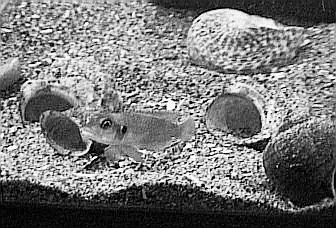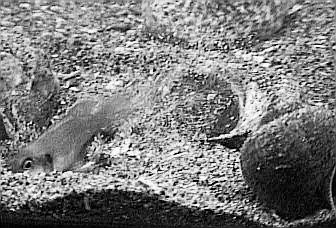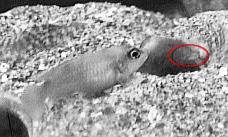
Unlike most other rift lake cichlids, Neolamprologus ocellatus and a handful of other species are very small (typically under 2 inches) and they live and breed inside abandoned shells.
Dave Sanford had been raising the gold
variety for a while
when we first saw them [see Dave’s spawning article
Lake
Tanganyika Gold
in the March 1997 Northwest Aquaria]. We thought
briefly of raising them, but fish store costs and lack of tank space
held us at bay until the fish were virtually forced upon us by fate...
We have a lot of fun attending the occasional neighboring club meeting in Portland. Usually it’s a special trip for a great speaker or annual show. Aside from hearing different speakers and meeting new fish nuts, we get to observe and participate in the strange rituals hitherto unknown to GSAS (at least in 1996): Bowl Show! Raffle! Mini auctions! In fact, their Breeders Award Program requires you to prove your spawnings by donating at least five fry to the club for auction. And we were thrilled to take home five L. ocellatus fry for $5 (guess everyone else in Portland already keeps them). Erik kept the little guys warm under his sweatshirt during the 3 hour drive home through December weather.
There wasn’t a tank ready, so we used a floating acrylic
pen
in our 60-gallon Julidochromis tank. The pen was basically
an oversized livebearer trap. Since the fry were only about 1cm long,
they would fit...for now. We added a few shells, fed them baby brine
shrimp and flake food. As they grew, adult brine was added to the
regimen, and we moved them out of the pen and into first a 6-gallon
tank, and eventually a 15. We had one casualty along the way... four
left.
This last tank was fun to aquascape. We went down to carkeek park
and got half a pickle bucket of beach sand, as well as a small pile of
rocks. After bleaching and dechlorinating it, we put a 3-cm layer of
sand in the tank, so they’d have space to dig, and piled the rocks in
one corner, fanning out
into the open space for the shells.
We make our own water additive out of calcium carbonate and magnesium carbonate, bought from chemical supply houses. Plants seem happier with this arrangement than other salt mixes, and it gets our pH up into the 8’s.

At first, the four fish divided the tank. Then as they started getting into their adult roles, the tank was divided into thirds with one fish left hovering at the top. After the hover-fish disappeared mysteriously, it became two fish (a pair) each taking up half of the bed of shells, with one other (a subdominant male) retreated to the corner of rocks. The dominant male began to take over much of the sandy area. He would sit near a shell and flap all his fins, causing sand to fly and completely seal the unused shell. Other shells he turned over altogether. Clearly, only his was to be inhabitable!

At first the whole area was his along, but soon the smallest fish was joining him (though with her shell at a few inches distance from his). We now know this one to be female because of the white edge at the top of her dorsal fin. We were delighted to see one day, a year after we got them, a spawn. The fry were tiny but quickly grew on baby brine shrimp. We think that feeding baby brine was one of the factors that induced them to spawn; some books theorize that certain fish will not spawn until there is appropriate food available for the fry.

Unfortunately, the fry gradually disappeared, except one. The
female spawned again, and soon we had another batch and discovered
what happened. The subdominant male, banished to his rock corner,
would occasionally swoop down like a hawk and gobble up fry when the
parents were distracted with food. When I first saw this, I pulled the
bandit out of the tank. But then the big male started beating on his
mate instead. The bandit was returned to his target fish
role. Two more spawns have come and gone this way since. We’re
thinking of removing the fry or parents next time around.
Kathy Olson is slowly coming around to the notion that there are other interesting fish aside from Apistogramma. In addition to the shell-dwellers, she also keeps Julidochromis.